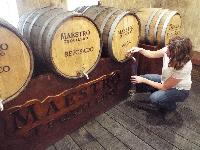
A short drive from Guadalajara, the town of Tequila pulses with the dry heat of the Central Mexican desert and is hemmed in by vast fields of blue agave cactus.
Their pointy arms stretch skyward in worship of Mayahuel – the Maya goddess of the maguey cactus, and coincidentally, of drunkenness.
 Flickr.com/Thomassin Mickaël (CCbySA2.0, colour edit)
Flickr.com/Thomassin Mickaël (CCbySA2.0, colour edit) Flickr.com/Thomassin Mickaël (CCbySA2.0, colour edit)
Flickr.com/Thomassin Mickaël (CCbySA2.0, colour edit)
A Town Called Tequila
Tequila might have been like any other quaint, colonial Mexican town if it weren't for the influence of the Jose Cuervo tequila company, who opened their original distillery here, La Rojeña, in 1758 and have been an omnipresent resident ever since. Their grounds include a sprawling hacienda large enough for wedding guests in the thousands, and a handful of decadent tequila tasting rooms – where I found myself just a few weeks ago, sipping aged tequila between bites of bitter chocolate.
Who knew the main attraction at Senor Frog's could be so decadent? Lots of people, actually.
A Brief History of Tequila
 Flickr.com/Enrique Vázquez (CCby2.0)
Flickr.com/Enrique Vázquez (CCby2.0)
Tequila has had a lot of incarnations in the general psyche of North America. It had its heyday in the Golden Age of Mexican movies when no hero or heroine was without a bottle in the service of wooing, whoring or winning the fight. It was also a cheap high for Americans during prohibition, who poured across the border looking to wet their whistle in the 20s and 30s. More recently, spring-breakers, off-duty military and underage drinkers have given tequila a reason to flow freely in the streets of Tijuana and the beaches of Cancun. But this spirit is achieving a glory that not even its first Spaniard masters, who produced tequila to substitute old-world spirits, envisioned for it.
Traveller Taste Test
 Lydia Carey
Lydia Carey
In Cuervo's tequila tasting room a variety of sipping glasses are proffered only to be shown, one by one, of being inadequate for the task of taking in the full sensory experience of a good tequila. Only Reidel's special tequila glass remains standing – tall and thin like a champagne flute only a tad shorter and plumper at the base. Each variety of tequila – blanco, reposado, and añejo – are sampled with elements that complement and enhance them – salt & lime, bitter chocolate, and caramelly, sweet-baked agave heart.
The Maestro Tequilero (Tequila Master) for the day instructs the room on every detail of drinking tequila including which tequilas should never be mixed (100% agave tequilas are sipped neat), how to avoid evaporating the alcohol with the heat of your hands (obviously, the tequila glass) and even how to breath properly when taking your first sip of the night (breath in through your nose, hold it, swallow, breath out through your mouth).
DIY By Design
 Lydia Carey
Lydia Carey
The tasting takes some faith in yourself because after a handful of sips you are asked to mix your own tequila blend based on your favorites of the three varieties. It's nerve-wracking, but immediately dissolves any stuffiness in the room as everyone becomes their own tequila mad scientist. Once you find a blend you like, you're invited to mix an even bigger sample into a commemorative bottle and seal it with blood-red wax, giving the whole thing a proper Zorro feel.
Don't trust yourself to mix the magic? Leave it to the experts and take the Tequila Express from Guadalajara to Tequila where an open bar awaits with Cuervo's best 1800s tequilas and a big pour of the Reserva Familia, which is their top-shelf bottle. Or take a tour into the damp tequila cave below the Rojeña factory to see Cuervo's ancient tequila stash – bottles that have been preserved for over 200 years that sell for about $1,500 USD a pop.
Tequila: The Champagne of Mexico
Tequila distilling predates the production of bourbon by about 250 years. Tequila, Jalisco and certain parts of Guanajuato, Nayarit, Tamaulipas and Michoacan states are the only places in Mexico where tequila is produced (using only the blue agave cactus). A little like champagne in Champagne, tequila has been recognized as the intellectual property of these areas and its making must adhere to various regulations and restrictions. A surge of high-end and super premium brand tequilas has skyrocketed in the last ten years, and that, in addition to celebrity endorsements on both sides of the border and the luxury tasting experiences to be had if you willing to pay the price, have been a boon to tequila sales around the world. Cuervo is capitalizing on its homebase with a new luxury hotel, an upcoming arts center and a half-dozen tequila experiences offered in the surrounding area.
Pulque may be Mexico's most ancient party-maker and mezcal its hipster export, but tequila is regaining its good name among the world's most unique, sophisticated, and delicious sipping spirits. Isn't it time you tried some for yourself?
Lydia Carey is a freelance writer madly in love with Mexico City. Her work has been published in Afar, Luxury Latin America, The Latin Kitchen and more. She is the author of “Mexico City Streets: La Roma,” an in-depth guide to one of Mexico City's most fascinating neighborhoods. Find her at her blog mexicocitystreets.com or on the street, taco in hand, enjoying the view from the sidewalk.
Have you taste-tested tequila in Mexico?
What's your go-to brand?


